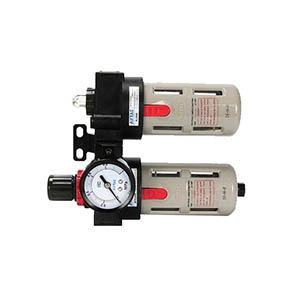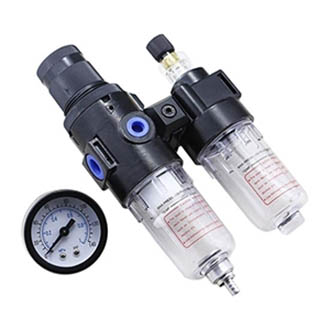Factors Affect Air Filter Efficiency
Air filter basics
Air Filter (Air Regulator Filter) refers to an air filter device, generally used in clean workshops, clean workshops, laboratories and clean rooms, or for dust prevention of electronic mechanical communication equipment. It is often made of artificial fiber filter material, and the outer frame is made of strong, moisture-proof cardboard frame. It will not be deformed, broken, or twisted under normal operating conditions.
In addition, the filter material is fixed according to the diagonal line before and after the frame. The filter material and the outer frame are tightly bonded to the outer frame to prevent air leakage. The air filter is to obtain clean air in order to meet the standard.
The general ventilation filter is to capture and absorb dust particles of different particle sizes in the air to improve the air quality. In addition to absorbing dust, the chemical filter can also absorb odor, usually used in biopharmaceuticals, hospitals, airport terminals, human settlements and other places. Generally, filters for ventilation are widely used, and are needed in the microelectronics industry, painting industry, food and beverage industry, etc.
Usually, we often divide it into 3 types, including primary filter, intermediate filter, high efficiency filter and sub-high efficiency. Various models have different standards and performance. Among them, the working efficiency of air filters is closely related to their own performance. Let's take a look.
Filtration accuracy
Refers to the maximum diameter of impurity particles that are allowed to pass through. The key that affects the filtration accuracy is the filter element. Different filter elements can be selected according to the needs of the following components to achieve the corresponding filtration accuracy. Filtration accuracy indicates the ability of the filter to remove various pollutant particles, and is often evaluated by indicators such as absolute filtration accuracy and filtration ratio.
Absolute filtration refers to the maximum size of hard spherical particles passing through the filter element, which reflects the maximum through hole size of the filter element. It is generally required that the absolute filtration accuracy should be less than half of the gap between the kinematic pairs between components. Absolute filtration accuracy is the most important performance index to consider when selecting a filter.
Filtration ratio refers to the ratio of the number of particles larger than a certain size before and after the oil is filtered through the air filter. Filtration ratio can accurately reflect the filtering ability of the air filter to different sizes of particle pollutants. Because of its simple test method, it has been adopted by the International Organization for Standardization as a performance index for evaluating the filtration viscosity of the filter.
Flow characteristic
It refers to the relationship curve between the air flow through the filter and the pressure drop at both ends of the filter under a certain inlet pressure. In actual use, it is best to choose within the range of pressure loss less than 0.03MPa. In an air filter, the main body and the filter element mainly affect the flow characteristics.
Water separation efficiency
It refers to the ratio of the separated moisture to the moisture contained in the air at the air inlet. It is generally required that the water separation efficiency of the air filter is not less than 80%. The main factor affecting the water separation efficiency is the deflector.
Air filters have different filtration efficiencies measured with different concentrations.
Gravimetric efficiency Dust concentration is expressed in mass concentration (g/m³)
Counting efficiency Dust concentration is expressed in counting concentration (pc/L)
Sodium flame efficiency Use sodium chloride solid particles as dust source. The concentration of sodium chloride particles was measured by a photoelectric flame photometer. Sodium flame efficiency is comparable to counting efficiency.
Filter resistance
The resistance of a new filter under the rated air volume is called the initial resistance. The initial resistance of the air filter refers to the air circulation resistance of the newly made filter under the condition of rated air volume. The air filter operates under a certain air volume, and its flow resistance increases with the increase of dust accumulation.
Under the rated air volume, when the resistance is large enough to clean or replace the filter material, it is called the final resistance. Generally, when the amount of dust accumulation reaches a certain value, the resistance increases rapidly. At this time, the filter should be replaced or cleaned to ensure the economical operation of the purification air conditioning system.
When designing, a representative filter resistance value is required. This filter resistance value is called "design resistance". The general method is to calculate the average value of the initial resistance and the final resistance. In most cases, the final resistance of the filter is 2 to 4 times the initial resistance. When the filter reaches the final resistance, the filter needs to be replaced, which can be judged by installing a resistance detection device in each filter section, such as a differential pressure gauge.
Dust holding capacity
Under the rated air volume, when the resistance of the filter reaches the final resistance, the total mass of dust particles it holds is called the dust holding capacity of the filter.
Air particles
When the air filter ( For example,1/4" 1pc pneumatic filter) pass polydisperse particles, under the action of several filtration mechanisms, relatively small particles are first deposited on the fibers due to diffusion. So when the particle size increases from small to large, the diffusion efficiency gradually weakens. Larger particles are deposited under the action of interception and inertia, so when the particle size increases from small to large, the efficiency of interception and inertia increases gradually.
Even with the same particle size, particles in different phases have different effects on filtration efficiency. Relevant experimental studies have shown that the efficiency of filtering solid particles is higher than that of filtering liquids. As the filtration rate increases, the effect of this phase state on efficiency will gradually decrease.
The particles of some dust sources in the air filter efficiency test are spherical. When the spherical particles are in contact with the fibers, the contact surface is smaller than that of the irregular particles, so the probability of the contact between the irregular particles and the fibers is greater. The probability of deposition also increases. In fact, the particles in the filtered air are irregular, so the actual filtration efficiency is higher than the calculated and experimental values.
Air temperature
The temperature of the filtered airflow increases, which increases the diffusion coefficient of the particles and the diffusion efficiency of submicron particles. However, when the temperature rises, the viscosity of the gas becomes larger, which reduces the deposition efficiency of large particles relying on the gravity effect and inertia effect, and also increases the filtration resistance.

